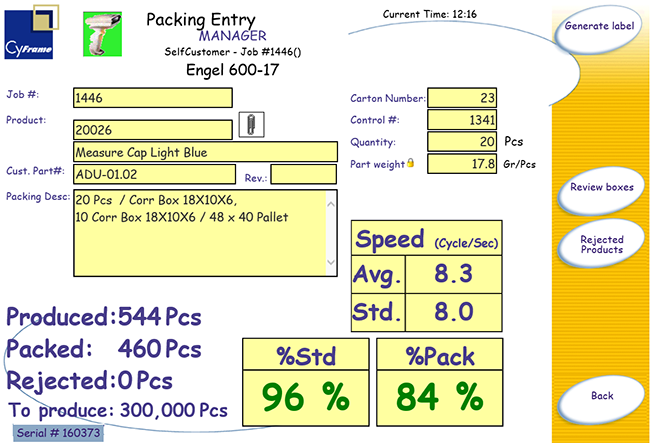Finding the Best ERP System for Plastics Processing
Implementing an enterprise resource planning (ERP) system in your molding or extrusion business should be one of the best investments you’ll ever make. But not just any ERP will do.
July 12, 2023

Pierre Maillet
Each manufacturing sector has a distinctive set of tools, processes, technologies, and challenges. These differences make it extremely difficult, costly, and time consuming for manufacturers to adapt one-size-fits-all solutions to meet their unique needs and applications. So, why do some plastics processors attempt to integrate manufacturing and business processes through a generic enterprise resource planning (ERP) program? ERP systems not designed to integrate the complete plastics business workflow aren’t based on best industry practices and won’t drive process improvement or attain scalable bottom-line growth.
Let’s review some of the critical ERP aspects for plastics processors.
Optimizing implementation time and operational costs
Generic ERP systems typically require extensive customization, adding time and cost to deployment. By contrast, ERP embedded with plastics-industry manufacturing terminology and operational methods make product configuration intuitive, fast, and reliable. Instead of days, a plastics industry ERP can be put to work within hours. With embedded business rules and functionalities, your intuitive system will understand the implication of molds and dies and have intelligent “plastic-friendly” functions to save time and facilitate ongoing maintenance.
Staffing a generic ERP project can be challenging, whereas a plastics manufacturing ERP can slash operational costs by 50% or more in 10 to 15 years.
An ERP module that is robust and intuitive
Plastics processors cannot realize full ERP benefits without a robust production module. Because generic systems struggle to implement this module, companies will spend a small fortune on customization only to gain incremental functionality. Conversely, ERP systems with a plastics production module are generally simple and intuitive.
There are four major types of plastics processing: Injection and blow molding, profile extrusion, blown film, and sheeting/thermoforming. Each has a complex environment that requires special software handling, such as multi-layer recipes, co-extrusion, family molds, alternate plastic recipes, compound/regrind processes, raw material batches, inserts, and special tools like calibrators, line printing, and labeling. Plastics ERP vendors often will provide versions specifically designed for each type of process.
Most systems will have a major impact on calculating exact product costs and material requirements or simply scheduling a work order that considers all constraints. Adding PLC controls with a touch screen/label printer data acquisition station is the simplest way to track finished goods, lot numbers, raw materials, rejects to regrind, and production profits.
The best advice is to perform trial runs with a small sample of your products from start to finish, even if that involves a cost.
Scheduling production and lead times
Plastics processors share a need to reduce downtime for improved production efficiency and overall equipment effectiveness. This is best achieved through intelligent, integrated planning tied to production efficiency and quality historical results on different machine alternatives as well as material availability, such as alternative recipes that must be connected to material requirement planning (MRP) and purchasing. Optimizing the use of available production capacity ensures on-time deliveries, increases the amount of quality finished goods produced with fewer rejects, and optimizes the use of raw material, resulting in overall profitability.
|
ERP systems help manufacturers to improve production efficiency and overall equipment effectiveness. |
Production scheduling can be complex. For the best results, follow these guidelines:
To optimize overall production runs, identify upfront the machine(s) that will be used.
Confirm that machines, dies and molds, and necessary secondary equipment — conveyors, grinders, calibrators, robots, co-extruders, and so forth — are available and are not assigned to other production runs or scheduled for maintenance.
MRP calculations should be dynamically completed online when a work order is moved to another production run date to instantly verify availability of the required equipment as well as the material needed in the plastic recipe. If a material is unavailable, you may be forced to use an alternative recipe.
Within your ERP system, all aspects should be visually available in a drag-and-drop graphic scheduling tool and it should provide visual warnings of any deadline delays, material problems, or equipment conflicts.
Production data acquisition — the big payback
Enabling production line operators to print package labels confirms that X units were produced with accurate resin lot number tracking and quality control information on the label. This includes capturing critical production efficiency metrics such as production speed and yields along with valuable product and management information while eliminating many front-office tasks.
|
Capturing accurate production data through an ERP system eliminates many front-office tasks. |
Further, adding a PLC panel verifies the true machine speed and product count — those automatically counted by the PLC — versus the speed calculated based on the packaged one for your finished product as well as against the speed defined in the product configuration for its estimated cost. This is the best automated way to know your exact profitability in real time and quickly take corrective measures, as needed, based on real-time production performance information. Furthermore, you’ll know at the end of each day if your production floor met its daily profit target.
Tracking resin lots to finished goods certificates
Many plastics processors have tight quality requirements, especially for medical, food, and pharmaceutical applications. Generating a tracking number for raw material lot numbers, the machine(s) and tool(s) used, as well as equipment operator(s) involved in production is a requirement for those industries.
Performing these steps manually is labor intensive and prone to error. A plastics ERP will automate the entire quality tracking process and generate the necessary QA tracking certificates. This is easily overlooked when selecting ERP software, yet it represents significant financial benefits for processors serving or wishing to serve the medical, pharma, or food packaging industries.
Regrind processing complexities
Grinding plastic part excess or rejected parts in pellets (regrind) is an indispensable reality for most processors. Expenses can mount if this aspect is not properly handled by an ERP system.
First, regrind can be part of the production process. A production line grinder can be installed to add back to the raw material intake (hopper) of the machine. This requires a special calculation for the MRP, which would otherwise be inaccurate.
Second, things can get complicated when regrind is used in a single- or multi-layer plastic recipe. Processors must know how much regrind will come from inventory versus material grinded on the production line. Again, the MRP must take this into consideration.
Third, there are often different grades of regrind. Plastic parts made with regrind that has been processed many times will lose a certain amount of their virgin properties. In such cases, additives must be added to the regrind to regain these properties, which calls for a different plastic recipe.
Finally, the regrind part number must relate to the original plastic recipe. This allows any rejected parts to be automatically correlated to that regrind raw material number.
ERP developed for plastic processors will efficiently handle the regrind process as well as perform the correct MRP calculations. This is overlooked by many ERP systems and leads to inaccurate allocation of raw material inventories. While these may sound like simple issues, they are in fact complex, and nobody likes financial surprises at month’s end from inaccurate inventories.
Online costing
Because resin and additive prices fluctuate, plastics processors must be agile when plastic recipe components are affected. This can be complex, as costs can vary greatly from one product to another depending on resin recipe percentages in a product. Recalculating product cost, whether it involves resin, packaging, machine, or labor, should be automated and online. It should suggest a new selling price to maintain profit margins.
This should be completed prior to confirming a new order. Not only does the cost need to be verified with the latest raw material prices, but production efficiency of previous runs — actual versus estimated production speeds, setup times, and reject rates — should also be checked. Assumptions from the original estimate often require an adjustment affecting product cost and price.
Purchased parts and subcontractor scheduling
Many plastics manufacturers must purchase special parts and subcontract work as part of their production process. Special attention should be given to the production scheduling step. This includes automatically creating all purchase orders at the order entry stage with the capability of shipping plastic parts mid-stream during production and receiving them back to complete the order or getting the subassembly supplier to ship the assembled parts to the customer.
Performing this manually in the front office is expensive and should be automated. If you’re not taking advantage, you may consider this to be an opportunity to generate future revenues and create a stronger bond with existing or new customers.
Shipping nightmares
Over and under shipping is a reality for many plastics processors. Companies may have an outstanding production run and want to produce a bit more, or they might be having problems such as impurities and buildup, especially in a long production run, and want to produce a little less. It is often understood and fully accepted by customers that plastics processors may ship a certain percentage — typically around 5% — over or under the ordered quantities.
However, many generic ERP systems don’t react well when the customer order fails to match the quantity shipped. Closing an incomplete shipping document or allowing an over shipment can be complicated. And failing to close unshipped orders will result in poor visibility, with a jungle of pending unshipped orders. An ERP designed for plastics processors will allow users to easily close shipping documents when over-under shipments occur.
Customization and updates
Generic systems generally require a fair amount of customization to work for plastics manufacturers. The problem with software customization is that it is expensive and makes the move to a new version very difficult and costly. As core components — operating system, database, etc. — are no longer supported, users are forced to move to a new version of the software. When considering a system, you should know in advance the implications and costs of keeping the software updated without creating problems with previous customizations.
Some ERPs will have limited software customization options, which will reduce your capabilities. On the other hand, a plastics industry ERP system will have a strict minimum amount of customization required for implementation. This is a great advantage, not only from a cost perspective but also to keep your ERP system up to date.
A team specialized in plastic manufacturing
When committing to an ERP provider, you’re essentially entrusting them with the future of your business. Identify a software company that understands your business, speaks your language, and truly delivers benefits if you want to realize substantial long-term gains.
While the total accumulated benefits of an ERP are immeasurable, implementation carries a risk if you’re not selecting the right system. An article from Pemeco Consulting, “Two Big Reasons Why ERP Implementations Have Failure Rates Higher than 50%,” includes research data that put this into perspective:
Business research and advisory firm Gartner Inc. says that ERP implementation failure rates can exceed 75%.
Similarly, global management consulting firm McKinsey & Co. estimates that 70% of all digital transformations fail.
When you select a system developed by plastics professionals, you’re working with people who understand your business. What’s more you’ll have direct access to industry veterans whose input can help maximize your ERP investment and advance your operations.
The bottom line
The right ERP system will help you scale up and grow your business with a solid enterprise infrastructure. It will also add strong value to your business by ensuring continuity instead of relying on a few key people with spreadsheets.
The ERP system you select will dictate how you run your business for the next 10 to 15 years. You are essentially entering into a partnership with a software provider that will help you evolve toward a more efficient business during that period. Being confident this is the right partner for you should be a major consideration with a solid proof of concept.
While software selection consultants can offer some sound general advice, letting them run the selection process and activities is not advisable unless they know your business inside out. These specialists typically run the ERP software selection process with a 300-point request for proposal (RFP) process — and two hundred of those points are probably irrelevant to your business. Instead, focus and drill down on the key needs and opportunities that will make a difference in your company’s efficiency and profitability.
Here's the bottom line: Select a plastics industry–focused ERP from a provider that invests in perfecting its solution and who understands the plastics industry and its unique processes, challenges, and opportunities.
About the author
Pierre Maillet is founder of CyFrame International Enterprises Inc., which helps tooling manufacturers and plastics processors improve production efficiency and profitability. A graduate of the University of Ottawa, Maillet is a CPA. Prior to CyFrame, he worked as a software applications specialist (Hewlett Packard) and IT management consultant (KPMG).
About the Author(s)
You May Also Like






